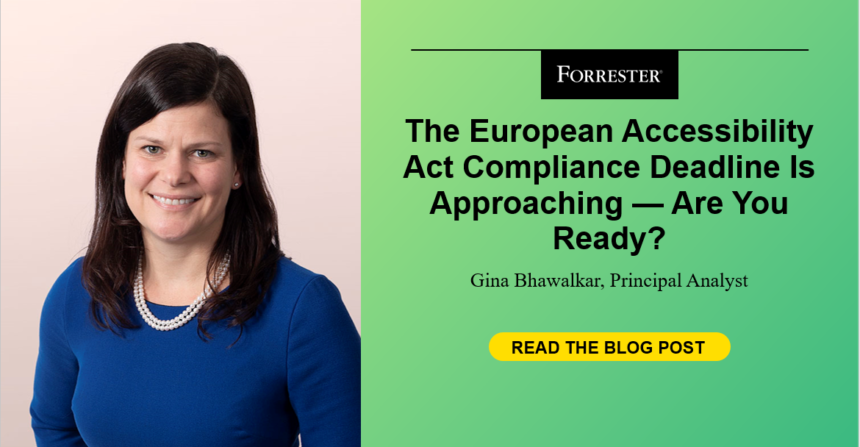According to Forrester data, 59% of companies have executive commitment to creating accessible products and are doing the work to deliver on those commitments. I’ve written extensively about how commitments to diversity, equity, and inclusion drove that percentage up in recent years. But right now we’re beginning to see the pendulum swing back towards compliance being the primary driver prompting organizations to commit to and mature their accessibility practices. Why? One reason is the European Accessibility Act (EAA). Like in the privacy space, regulations have played a critical role in elevating accessibility on the priority list for businesses. Forrester received many inquiries from clients in Canada leading up to the 2021 information & communications deadline imposed by the Accessibility for Ontarians with Disabilities Act (AODA). We expect the impact of the EAA to be even greater given its scope.
What Do I Need To Know About The European Accessibility Act?
Here’s my main takeaways on the EAA:
- The act applies to companies that do business in the European Union. While there are some exemptions – for small businesses for example – if you’re a Forrester client, or any enterprise company reading this blog, it’s likely the act applies to you.
- Adopted in 2019, the act establishes common requirements for accessibility across the 27 EU member countries. Each country is required to implement the act in their national laws. As an example, read about how the EAA is implemented into Irish law. The EAA is aligned with other EU accessibility legislation such as the Web Accessibility Directive which applies to public sector bodies. If you’re familiar with EN 301_549, which focused on the public sector, this act essentially extends those requirements to businesses as well.
- Countries are required to begin enforcing the law in June 2025, so consider that your deadline for compliance.
- There are penalties for not meeting the requirements. For example, Ireland’s law notes fines of up to 60,000 euros, while in the Netherlands supervisory authorities can issue fines of up to 90,000 euros or 900,000 euros depending on the authority.
- Unlike accessibility laws in other regions, the EAA doesn’t name the Web Content Accessibility Guidelines (WCAG) as the standard. But given WCAG is the global technical standard for creating accessible digital experiences, it’s safe to say that this is the standard you need to adhere to for any digital products, services, and experiences.
What Should I Do About It?
Complying with the EAA isn’t a one-and-done project or check-the-box exercise. You need to embed accessibility into how you run your business and how you create products and services. If you’re already doing that — regardless of whether that was prompted by regulations in the regions you operate in or other drivers — my answer to the question “what should I do?” is “just keep doing what you are doing.” But if the EAA is what has prompted your organization to get started, here’s where I recommend you begin:
- Raise awareness of the benefits of accessibility. You need to lay the foundation for accessibility to take hold in your organization. The way to do that is to elevate awareness of what accessibility is, why it matters, and what it requires of your organization. The business case for creating accessible digital experiences is strong, so while the act can be used to force the conversation it’s important to help leaders and teams understand the broader benefits. Focus on how businesses that create inclusive experiences can increase revenue, decrease costs, improve resilience, and build trust with customers and employees.
- Understand where you stand. Start with your most important products, applying a user experience mindset by focusing on features that align with your customers’ top tasks. Many companies engage with accessibility vendors for help with auditing existing experiences, and this is a particularly important step if you’ve not yet hired in-house accessibility experts. It’s also a good idea to procure a digital accessibility platform to help you identify accessibility issues, facilitate remediation of issues, and monitor and report on the compliance of your company’s experiences.
- Establish your organization’s accessibility practices. In parallel to assessing where your products are today, put the necessary processes in place to embed accessibility into all new digital experience design and development work going forward. Work with each team (product, design, development, testing, program management) to integrate accessibility into their practices, put mechanisms in place for running research with customers with disabilities, and integrate accessibility into your company’s design system.
Forrester clients can read these Forrester reports for more best practices and examples of how to get started:
Participate In Our Research
Is the European Accessibility Act prompting your organization to initiate, establish, or scale your digital accessibility practices? I’d welcome the opportunity to interview you for my research. If you’re interested in speaking with me, please get in touch! If you’re a Forrester client your account team can help connect you with me, and if you’re not please reach out via LinkedIn. I’d love to speak with you.
If you’re a Forrester client and would like to discuss the EAA further, and understand how to prepare, set up a conversation with me








